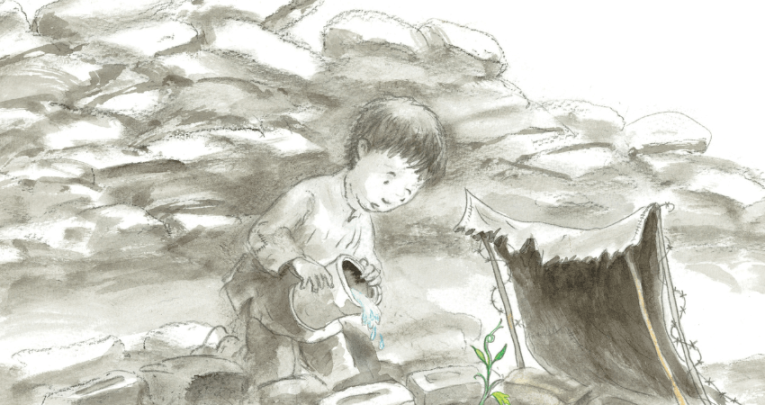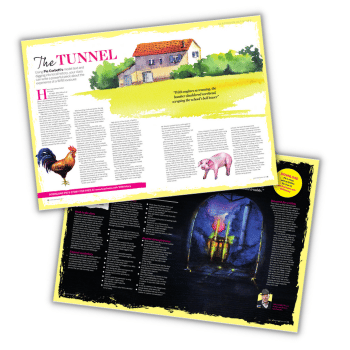Books about wars – 10 recommendations for primary

Books about war are invaluable in helping children explore and consider difficult subjects from within a safe space…

Freelance writer and creative consultant Carey Fluker Hunt recommends ten of the best books about wars for primary students…
Foundation Stage books about wars
1. Green Lizards vs Red Rectangles
by Steve Antony, Hachette Children’s Group
About this book
Why are the squashy lizards and hard-edged rectangles at war? No-one knows, but fighting continues until they’re forced to find a way to co-exist. Their solution delights just about every reader: a bright red structure with plenty of white space for the squashy lizards… could it be a block of flats? Who knew that creative and co-operative thinking could result in such an effective compromise?
This quirky picturebook is a great way to explore conflict and its resolution, and makes an eloquent visual and emotional case for peaceful co-existence. We all benefit from each other’s strengths and differences, and Steve Antony’s light-touch exploration of complex ideas will prompt some thoughtful responses.
Thinking and talking
- Why do you think the rectangles and the lizards are at war?
- How do they eventually share their space? Do you think it’s a good idea?
- What do you argue about? How do you solve your problems?
Try this…
- Create patterns on white paper with red rectangles, then choose your favourite design. Draw green lizards in the gaps.
- Look at the final spread. How do the lizards and rectangles feel, and what do you think they’re saying to each other? Add sticky notes with more dialogue, or role play their conversation.
- Use contrasting sets of paper shapes to make ‘war’ and ‘peace’ pictures. Talk or write about what you’ve done.
2. The Little War Cat
by Hiba Noor Khan, illus. Laura Chamberlain, Macmillan Children’s Books
About this book
The little grey cat used to play beneath the palm trees in Aleppo, but everything has changed since the ‘humans in boots’ brought war to its streets. Luckily, one human still cares for stray and homeless creatures in a kinder place, and once the little grey cat has eaten and rested, she’s able to offer comfort to a lonely boy.
Told from the perspective of a lost and frightened feline, this picturebook about the transformative effects of hope and kindness depicts some of the realities of war in an age-appropriate way.
Thinking and talking
- What’s happened to the little cat’s city? How has it changed?
- Who or what helps her to feel better?
- Who’s been kind to you? What did they do, and how did you feel?
Try this…
- Pretend you’re the little boy. Tell the story of the day you met the grey cat. What happened next?
- Paint a picture of the cat. How does she feel when people are kind to her? How does she feel when she’s kind to the boy? Work together to list words, then write them around your picture.
- ‘A little kindness goes a long way…’ Share examples of being kind. Can you decide who benefits from the kindness? Maybe there’s a ripple effect, where the kindness is passed on? Record your ideas in pictures and words.
Key Stage 1 books about wars
3. The General
by Janet Charters, illus. Michael Foreman, Templar Books
About this book
A much-decorated general demands daily shooting practice and rules his army with precision. The scene seems set for military confrontation. Until he falls off his horse in a grassy meadow, notices the flowers and the bees, and experiences a change of heart that affects everyone.
This ‘celebration of peace and beauty’ was first published in 1961 during the Cold War, but its powerful message remains as relevant as ever.
Thinking and talking
- General Jodhpur wanted to be so famous that someone would write a book about him. Would the story in this book have surprised him? How?
- Did the soldiers want to go to war? What do they do instead, and how do you think they feel about it?
- Could your school be more peaceful? Share ideas for change, then try them out.
Try this…
If the three generals came to your school, what would they admire? Go on a tour of inspection and make notes. Then write and illustrate a report about the good things you’ve noticed.
Paint flowers from observation, then collage them on a frieze to create a meadow scene. Draw yourselves looking happy, like the General. Add everyone’s portraits to your display.
Discuss how the General feels and what he’s thinking on the first and final spreads. Write a letter from the General in the meadow to his younger self, advising him on why he needs to change, and what to do.
4. Saving the Butterfly
by Helen Cooper, illus. Gill Smith, Walker Books
About this book
Two siblings are rescued from a capsized boat and taken to a camp. The little one is soon playing out with friends, but his big sister won’t leave their hut. When a butterfly becomes trapped indoors, she must decide whether to leave it to its fate or offer help. Will she find the courage to take the butterfly outside?
The children’s trauma is not defined or shown in this moving picturebook, but readers are invited to empathise with its impact as the lyrical text and expressive artwork take them to the story’s heart.
Thinking and talking
- Why doesn’t the girl want to go outside? How does the butterfly help?
- What do you enjoy about playing outside with your friends?
- Have you ever felt afraid of doing something? What happened?
Try this…
- Look at the picture of the children playing. Where and how do you play? Why does play matter so much? How would you feel if you weren’t able to play? Write about your thoughts.
- Make big painted butterflies. Write sentences about peace on their wings, then hang them where they will make an impact.
- Collage a paper quilt using beautiful squares designed by everyone in your class or school. Does anyone in your community make blankets for refugees? Ask them to talk about their work. Could your class help?
Browse more resources for Refugee Week.
5. A Child’s Garden: A Story of Hope
by Michael Foreman, Walker Books
About this book
When a boy spots a green shoot in rubble near a fence, he nurtures it; only to see it destroyed by soldiers. But it isn’t dead, and with help from a child on the other side of the fence, it is reborn.
Set in a landscape of ruined houses and barbed wire, this classic picturebook depicts the desolation of war. Monochrome pencil drawings of the boy and his bleak environment are brought to life by the colours and vibrancy of the vines that no-one – not even a soldier – can destroy.
Thinking and talking
- What could have happened before this story began? Why is the fence there? Share ideas.
- ‘Roots are deep and seeds spread.’ When does the boy say this? What does he mean?
- Have you ever watched something grow? Do you have a special outdoor place you love?
Try this…
- Bring vitality and hope to images of monochrome landscapes by adding coloured vines and flowers. Imagine you’re walking into your picture. Write about what you see, smell, hear and touch.
- Look at the picture of the family in their ruined home. What do they need? Who could help them? Research the work of the Red Cross/Crescent and other charities.
- Could you plant a flower tub in school for everyone to enjoy, or transform an outdoor area by creating a small garden? Work together to implement your plan.
Key Stage 2 books about wars
6. How War Changed Rondo
by Romana Romanyshyn and Andriy Lesiv, Enchanted Lion Books
About this book
Danko, Fabian and Zirka live in Rondo, a town famous for its singing flowers; until the darkness of War arrives and steals their music. Danko, Fabian and Zirka try to fight War on its own terms, but it takes creative ingenuity, co-operation and beauty to defeat it, rather than brute force.
Supported by the Translate Ukraine Program, this powerful allegory speaks from the heart about timeless issues with strong contemporary relevance. In the company of kind and eccentric creatures who don’t appear strong enough to battle anything, children are encouraged to value what matters and work together for a better world.
Thinking and talking
- What impact does War have on Rondo?
- How do Danko, Fabian and Zirka defeat it?
- What have you heard about the war in Ukraine? Has it changed your lives? How?
Try this…
- Rondo’s anthem is Mozart’s Rondo alla Turca. Listen to the music as you paint brightly-coloured flowers. What would they sing about? Share ideas, then compose a peace-song for your flower chorus.
- What does Zirka see from above, as the light-machine battles War’s darkness? Record her observations in words and pictures on white paper squares, then fold into origami birds.
- Use the text, images and your imagination to build pre- and post-war character studies of Danko. What does he learn? How does he change? What would post-war Danko tell his pre-war self? In pairs, roleplay the conversation.
7. When Stars are Scattered
by Victoria Jamieson and Omar Mohamed, Faber & Faber
About this book
Omar and his disabled brother have been at Kenya’s Dadaab refugee camp for seven years. They want to go home, but while they’re waiting – for their mother to find them, for the war in Somalia to end, for another country to offer them a visa – Omar cares for Hassan, struggles to get an education and dreams of a better life.
Told in an engaging and accessible graphic novel format, this story is based on the real-life Omar’s own experiences, and emphasizes the importance of friendship, dreams, hard work and hope. It brings the impact of war to life for children in UKS2 and makes a good starting point for factual research and discussion.
Thinking and talking
- Has this book, or other books about wars, changed your understanding about life in a refugee camp? How?
- What impact does caring for Hassan have on Omar?
- How does Omar’s life in the camp differ from yours? In what ways is it similar?
- What challenges do Omar and his friends face? What attitudes, behaviours and skills help them stay positive? What could you learn from the children in this story?
Try this…
- In role as a character in this book, write a letter to your class. What do you want them to know about life in the camp, and why?
8. Saffiyah’s War
by Hiba Noor Khan, Andersen Press
About this book
During the occupation of Paris in WW2, Saffiyah’s father hides hundreds of Jewish families inside the City Mosque, where Saffiyah and her parents live. When the Nazis raid the Mosque, the Jews must be led to safety through dangerous underground tunnels, but only Saffiyah can take the lead…
This exciting and involving story was inspired by the true story of Sidi Abdel-Qadir Benghabrit, rector of Paris’ City Mosque, and brings the reality of wartime occupation vividly to life.
Thinking and talking
- What did you know about WW2 before you read this book? What has it added to your knowledge?
- How does Saffiyah’s life in Paris change during the Nazi Occupation? How does life change for people of other faiths?
- How did Saffiyah use her talents and interests to help the Resistance? How did she overcome her difficulties and fears?
Try this…
- Follow in Saffiyah’s footsteps by studying a 1940’s Parisian street map. Mark the places mentioned, then print photos of Paris under Nazi Occupation and display alongside.
- What does the text tell us about Baba’s support for the Resistance? What can you infer? Write a journal entry from Baba’s perspective, recording your actions and motives. Or deliver a speech in role, urging your audience to take action and explaining why they should.
- It’s easy to become pessimistic when there’s bad news, but good things are also always happening. Research, write and illustrate ‘good news’ stories, and publish as a class newspaper.
9. War
by José Jorge Letria and André Letria, Greystone Books
About this book
War takes on the brutal shape of all our fears…
What is war, and how does it affect the people and places it conquers? In this picturebook for older readers, powerful poetic statements and surreal artwork in shades of grey and sepia provoke engagement and a strong response. Depicted as the shadow of a gigantic bird on ravaged land, or an onslaught of serpents, war brings misery to everything it touches, until nothing but silence exists.
Thinking and talking
- ‘If children are old enough to be bombed, they are old enough to read about it’ – Deborah Ellis. Do you think War is a children’s book? Should it be more hopeful?
- Are there any illustrations or statements you don’t fully understand? Could there be more than one interpretation? Share your questions and thoughts.
- ‘War begets shadowy, iron children.’ What could this mean? Can these ‘shadowy children’ be helped? How?
Try this…
- Who could the figure in the window be? What do they want? Why are they alone? Hotseat this forbidding character and create a backstory. Could they be defeated? How?
- Work together to plan, write and illustrate PEACE, a sequel to this book.
- Make masks inspired by historical war helmets like the ones in this book, or create your own designs. Wear as part of a spoken-word performance of this text. Include your own introduction and afterword.
10. The Day War Came
by Nicola Davies, illus. Rebecca Cobb, Walker Books
About this book
When war arrives it’s an ordinary day, but soon the girl in this story is ‘ragged, bloody, all alone’, and her long search for sanctuary begins. A school in a distant, peaceful country offers the promise of a better life, but the teacher turns the girl away because there’s no spare chair. Can the pupils help…?
Nicola Davies’ lyrical text was prompted by the UK’s 2016 refusal to accept 3,000 unaccompanied child refugees, and a deep sense of outrage and injustice drives it. Powerfully illustrated, this moving picturebook will drive and inform creative projects across a wide age range.
Thinking and talking
- How is the girl’s distress and loneliness conveyed?
- How do you think the teacher feels? Does she mean to be unkind?
- Talk about symbols in this book. How are they used?
Try this…
- ‘A chair for me to sit on… and drive the war out of my heart…’ What makes you feel peaceful, hopeful and happy? Decorate your chairs, then sit on them while you draw or sing. Could you share your peace and hope with other children who need it? How?
- Use lots of different chairs to hotseat characters you’ve invented. Why have they left home? What are they hoping for? Working from observation, draw and paint the chairs and display alongside writing about your characters.
- ‘Pushing back the war with every step…’ Plan and take part in a fundraising walk to help children affected by war.
Carey Fluker Hunt is a freelance writer, children’s book ambassador and creative consultant. Browse WW2 KS2 resources, including our round-up of best WW2 books.











